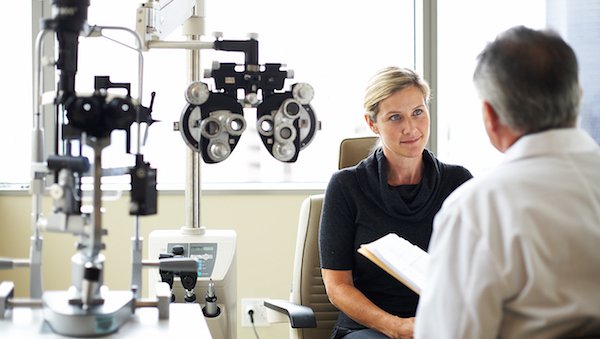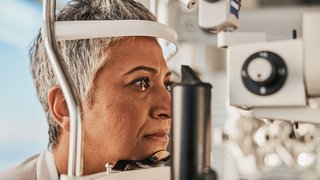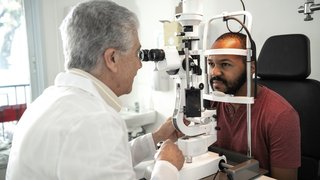Specialist spotlight: Paging Dr. Serdar Dogan
March 10, 2019

When Serdar Dogan was in medical school in Ankara, Turkey, there were a few things about the ophthalmology rotation that really caught his eye: the innovative technology, the precision required for each procedure, and the intrinsic complexity of the eye itself.
You might say for Dr. Dogan and ophthalmology, it was love at first sight.
Two decades years later, he is ready to bring his passion for ophthalmology – and for helping adult and pediatric patients with conditions like cornea and external diseases, cataracts with premium intraocular lenses, and pediatric ocular problems – to the new UT Southwestern Medical Center at Frisco when it opens Dec. 3.
Let’s get to know a bit more about Dr. Dogan (pronounced Doh-aan), his journey from Ankara to UT Southwestern, where he completed two fellowships (cornea and external disease, and pediatric ophthalmology and strabismus), and his ophthalmology residency. We’ll also find out why his eyes light up any time you ask him about Descemet’s membrane endothelial keratoplasty, or DMEK.
Is it true that ophthalmologists get the most impressive tools?
“It does seem like every year we are getting new technology. The techniques are getting so advanced we can customize treatments and provide good results for conditions like cataracts in a few hours. Transplants are a little more complicated, but with techniques like DMEK in certain pathologies we can get quicker visual recoveries.”
What is DMEK and where did you learn to perform the procedure?
“DMEK is a partial cornea transplant and the procedure allows us to replace just the inner layer of the cornea with donor tissue, which is about the thickness of plastic wrap. It’s a delicate procedure, but gives patients very rapid visual recovery and the rejection rate is lower compared with other techniques. UT Southwestern is one of the institutions that is skilled in both the procedure and preparing the tissue. We work closely with our eye bank.
“I first did DMEK when I was a cornea fellow at UT Southwestern. I was fortunate to be trained on new techniques during my first residency at Ankara University School of Medicine in Turkey.” Dr. Dogan would complete a second ophthalmology residency at UT Southwestern in 2019.
'Frisco is a booming area, and we are very lucky to have all the latest technology and equipment to offer our patients both in the procedure rooms and for surgery at the hospital.'
Serdar Dogan, M.D.
What is it about ophthalmology that drew you to it as your specialty?
“The eyes are complex. They work like a digital camera that’s connected to the brain with a very elaborate system of optical nerves. During my ophthalmology rotation, I got a glimpse of how all the advanced technology can provide positive results very quickly. Ophthalmology is all about precision, and we can be precise with the most complex surgeries. Quickly after a procedure, a patient can have improved vision and that impacts their life. I find that very satisfying to improve patients’ lives and meet their expectations.
“I learned a tremendous amount during my two-year cornea fellowship at UT Southwestern. I was able to advance my training in LASIK (laser-assisted in situ keratomileusis), and help improve patients’ vision.”
How do you feel about moving to UT Southwestern Frisco?

“It’s great. Frisco is a booming area, and we are very lucky to have all the latest technology and equipment to offer our patients both in the procedure rooms and for surgery at the hospital. UT Southwestern faculty from different subspecialities will also be available in Frisco, so we will be covering most of the eye problems there.”
Will you treat adults and children?
“Yes. I am also a part of the pediatric group at Children’s Medical Center in Dallas and Plano, and we will treat adults and children at UT Southwestern Frisco. Adults can tell us when they have severe pain or vision problems, but kids may not know what’s going on. That’s why screening children before school age is important. Sooner is always better.”
When did you know you wanted to be a doctor?
“When I was little, I always liked to read about how systems work in nature and the body, and use my hands to build or remodel things. In my mind, I was going to be a surgeon. I wanted to help people and the idea of being able to change something on someone’s body in a good way and see them happy appealed to me. I love that. I still do.”
You didn’t just fall for ophthalmology in medical school, did you?
“I met my future wife in medical school in Turkey. (Basak Dogan, M.D., is an Associated Professor of Radiology at UT Southwestern and Director of Breast Imaging Research.) She did a fellowship at MD Anderson in Houston and I matched for residency with UT Southwestern. That’s what led us to Texas. We had our daughter here, and now she is 10 and in the fourth grade. She is also a competitive gymnast and violin player.”
Is it difficult finding a work-life balance with two doctors in the family?
“We love what we are doing. It’s not difficult for us. We’ve built a life in Texas, and we are very excited to both be on the faculty here at UT Southwestern.”
How do you connect with patients who might be nervous about having their eyes examined?
“Listening is always where I start. The interesting thing about ophthalmology is we usually deal with healthy people who have blurry or impaired vision. Because of that, patients have very high expectations from our surgeries. So, first, I listen to their expectations and explain what I can offer. Although medicine is advancing, it is not always perfect. By understanding expectations and what’s possible, we meet at a place where both of us can be satisfied with the results.”










